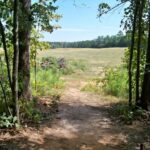Are you tired of looking out at your backyard and feeling uninspired? Do you want to make some changes but don’t know where to start? Look no further – with a few simple landscaping ideas, you can transform your outdoor space into an oasis.
As a professional landscaper, I have seen firsthand the impact that even minor changes can have on a backyard. Whether you are working with a small budget or just want to spruce up your existing landscape design, there are plenty of options available. From adding plants and flowers to creating focal points and incorporating lighting, these simple ideas will help elevate your backyard from ordinary to extraordinary.
Creating A Focal Point With A Water Feature
Water features are a great way to add interest and elegance to your backyard landscape. One of the easiest ways to incorporate a water feature is through a DIY project. There are many tutorials available online that can guide you in creating your own unique water feature.
When selecting plants for your water feature, it’s important to choose ones that thrive in moist environments. Some popular options include water lilies, iris, and cattails. These plants not only look beautiful but also help filter and purify the water.
Remember, the key to creating a successful focal point with a water feature is choosing the right location and incorporating complementary landscaping elements around it. With these tips in mind, anyone can create an impressive and relaxing outdoor space.
Adding Color And Texture With Plants And Flowers
To add color and texture to your backyard, plants and flowers are the way to go. Container gardening is a great option for those with limited space or who want easy-to-maintain arrangements. Choose colorful pots that match your outdoor decor and fill them with seasonal plant selections.
When it comes to selecting plants and flowers, consider their growth habits, colors, and textures. Mix tall grasses with low-growing succulents for contrast, or choose bright blooms like petunias or marigolds for a pop of color. Be sure to research which varieties thrive in your climate so you can enjoy healthy plants all season long.
Another fun idea is to create themed container gardens based on holidays or seasons. For example, you could use orange and black containers filled with spooky plants like black mondo grass and blood-red coleus for Halloween. Or, create a winter wonderland using white-painted containers filled with evergreens and red berries for the holiday season.
- Make DIY painted terra cotta pots as a fun weekend project.
- Use hanging baskets to add vertical interest to your outdoor space.
- Incorporate herbs into your container garden for an edible element.
- Don’t be afraid to mix different types of foliage together for added texture.
- Consider adding solar lights around your container garden for nighttime ambiance.
By incorporating these tips into your backyard landscaping design, you’ll have a vibrant oasis that’s both beautiful and functional all year round!
Incorporating Outdoor Lighting For Ambiance And Safety
Outdoor lighting is an essential aspect of creating a beautiful backyard landscape. It not only adds ambiance but also enhances safety by illuminating walkways and other potential hazards in the yard. When it comes to outdoor lighting, there are numerous options available for homeowners.
One cost-effective way to incorporate outdoor lighting into your design is by using DIY lighting fixtures. With some creativity and basic tools, you can create unique fixtures that will add character and charm to your backyard. Some popular ideas include mason jar lanterns, string lights wrapped around trees or pergolas, and solar-powered pathway lights.
Choosing the right bulbs for your outdoor lighting is crucial as they directly impact both the ambiance and energy efficiency of your space. LEDs are a popular choice as they consume less energy than traditional incandescent bulbs while providing bright light. Additionally, choosing warm-colored bulbs creates a cozy atmosphere perfect for relaxing evenings spent outside with family and friends. By carefully selecting the right bulbs, you can achieve just the right amount of illumination without sacrificing style or function.
Installing A Pathway Or Walkway
When it comes to transforming your backyard, adding a pathway or walkway can make a significant impact. Not only does it create an inviting entrance and clear path for guests, but it also adds dimension and texture to the overall look of your yard. Luckily, there are many DIY pathway options available that are affordable and easy to install.
Before starting any project, however, it’s important to choose the right materials for your pathway. Consider factors such as climate and foot traffic when choosing between concrete pavers, natural stone slabs, gravel, or mulch. Each option offers its own unique benefits in terms of cost-effectiveness, durability, and aesthetics.
For those who enjoy a more rustic look, consider using reclaimed bricks or stones for a charming antique effect. Alternatively, if you’re looking for something more modern and sleek, go with large-format tiles in neutral colors like grey or beige. No matter what style you prefer, installing a pathway is an excellent way to elevate the appearance of your outdoor space while providing practical functionality at the same time.
Creating A Cozy Seating Area With Outdoor Furniture
After installing a pathway or walkway in your backyard, it’s time to create a cozy seating area with outdoor furniture. Outdoor furniture selection is crucial because it will determine the comfort and style of your space. To make the most out of this project, consider these tips:
-
Determine the function of your space: Do you want an intimate setting for two or a large gathering spot for friends? This will help guide your furniture selection.
-
Measure your space: Knowing the size of your area will prevent overcrowding and ensure that each piece fits comfortably.
-
Choose durable materials: Since outdoor furniture is exposed to various weather conditions, opt for sturdy materials like wrought iron, resin wicker, or teak wood.
-
Mix and match styles: Don’t be afraid to combine different textures and colors to add visual interest to your seating area.
If you’re on a budget or looking for a personal touch, DIY furniture ideas are great alternatives. You can repurpose pallets into chic coffee tables or use cinder blocks as side tables. The possibilities are endless!
By following these guidelines, you’ll have a stylish and functional seating area that enhances your landscaping design. So grab some cushions, pour yourself a cold drink, and enjoy all that nature has to offer from the comfort of your own backyard oasis!
Using Hardscaping Elements To Define Space
When it comes to backyard landscaping, hardscaping elements can be a great way to define different spaces in the yard. Using pavers creatively is one way to create distinct areas for lounging or dining. For example, laying out pavers in a unique pattern or alternating colors can add interest and give the space a more custom look.
Another popular hardscaping element is building a fire pit. This not only creates an area for entertaining but also adds warmth and ambiance on cool evenings. When designing your fire pit, consider using natural stone or brick materials to blend in with the surrounding landscape. You may also want to think about incorporating seating around the fire pit for even more comfort.
Incorporating these hardscaping elements into your backyard design not only defines spaces but also adds beauty and functionality to your outdoor living area. With creativity and planning, you can transform your backyard into a stunning oasis that reflects your personal style and enhances your overall enjoyment of your home’s exterior environment.
| Advantages | Disadvantages | |
|---|---|---|
| Pavers | Easy installation, customizable designs | May shift over time if not installed properly |
| Fire Pit | Adds warmth and ambiance, great for entertaining | Requires maintenance such as cleaning ashes and monitoring flames |
| Natural Stone/BricK Materials | Blends well with surroundings, durable | Can be costly depending on type of material chosen |
Note: The above table highlights some advantages and disadvantages of using common hardscaping materials in backyard landscaping projects.
Maximizing Space With Vertical Gardening Techniques
Now that we have defined the space in your backyard using hardscaping elements, it’s time to maximize the remaining area with vertical gardening techniques. By creating a lush green wall or adding hanging planters, you can enjoy more of nature even in a small outdoor space.
One way to achieve this is by constructing DIY trellis designs. Not only are they easy and fun to build, but they also provide support for climbing plants like ivy or honeysuckle. You can place them along walls or on fences as an instant garden feature that adds height and texture.
Another option is to hang planters from railings or hooks. This not only creates a stunning visual appeal but also allows you to grow herbs, vegetables or flowers without taking up valuable ground space. When choosing plants for your hanging planter, opt for varieties that thrive well in partial shade such as Boston ferns or petunias.
Lastly, consider incorporating stacked pots into your vertical garden design. These multi-tiered containers offer endless possibilities when arranging different types of plants together, making them perfect for smaller spaces where square footage is limited.
By following these simple tips and tricks, you’ll be able to create a beautiful and functional vertical garden in no time!
Frequently Asked Questions
How Much Does It Typically Cost To Hire A Professional Landscaper For Backyard Projects?
When it comes to hiring a professional landscaper for backyard projects, average pricing can vary greatly depending on the scope of the project and the experience level of the landscaper. Negotiating rates is always an option, but be sure to take into account any additional fees such as materials or equipment rental. As a landscaping expert, I recommend doing your research and finding a reputable and experienced landscaper who can provide you with a detailed estimate before beginning work on your backyard oasis. Remember that investing in quality landscaping can add significant value to your property and enhance your outdoor living space for years to come.
What Are Some Low-Maintenance Plant Options For Those Who Don’t Have A Lot Of Time To Devote To Gardening?
When it comes to choosing low maintenance plant options for your backyard, there are a few key things to keep in mind. First, consider opting for shrubs that require minimal pruning and can withstand different weather conditions. Low maintenance shrub options include boxwoods, barberries, and junipers. Additionally, selecting drought resistant ground cover choices like creeping thyme or sedum can help reduce the need for frequent watering and upkeep. These types of plants not only save time but also add texture and color to your outdoor space without requiring too much effort on your part. As a landscaping expert, I highly recommend incorporating these low-maintenance options into your backyard design to create a beautiful yet practical outdoor sanctuary.
Are There Any Backyard Landscaping Ideas That Are Particularly Well-Suited To Small Spaces?
When it comes to maximizing small backyard spaces, vertical gardening is a fantastic option. By utilizing walls and fences for climbing plants or installing hanging planters, you can create a lush garden without sacrificing space. Creative lighting also plays a huge role in making small backyards feel larger than they are. Use string lights or lanterns to create ambiance and highlight focal points like water features, which can add both visual interest and the soothing sound of flowing water to your outdoor oasis.
How Can I Incorporate Sustainability Or Eco-Friendly Practices Into My Backyard Landscaping Design?
To create a sustainable backyard landscaping design, consider incorporating rainwater harvesting and native plant species. Rainwater harvesting involves collecting and storing rainfall to use for watering plants instead of relying on municipal water sources. This not only conserves water but also reduces your utility bills. Additionally, using native plant species in your landscaping can benefit the local ecosystem by providing habitat for wildlife and reducing the need for fertilizers or pesticides. As a landscaping expert, I highly recommend these eco-friendly practices for anyone looking to enhance their outdoor space while minimizing their environmental impact.
What Are Some Common Mistakes To Avoid When Attempting Diy Backyard Landscaping Projects?
As a landscaping expert, I’ve seen plenty of homeowners make common mistakes when attempting DIY backyard landscaping projects. One tip is to avoid overplanting and overcrowding your space. It might be tempting to fill every inch of soil with plants, but this can actually hinder their growth and limit the overall aesthetic appeal of your yard. Another mistake is neglecting proper maintenance practices such as watering regularly or pruning back overgrown branches. Before embarking on any backyard project, take some time to research and plan accordingly. With these simple DIY tips in mind, you’ll be well on your way to creating a beautiful, sustainable outdoor oasis that you can enjoy for years to come.
Conclusion
In conclusion, creating a beautiful backyard oasis doesn’t have to break the bank or take up all your time. With some careful planning and consideration of low-maintenance plant options, you can easily transform your outdoor space into a tranquil retreat.
As a landscaping expert, I highly recommend incorporating sustainable practices into your backyard design. This could include using native plants that require less water and maintenance, installing rain barrels or drip irrigation systems, and composting organic waste instead of sending it to landfills. By making small changes like these, you can not only create a stunning outdoor space but also help protect our planet for future generations. Remember to avoid common DIY mistakes such as overplanting, improper spacing, and neglecting soil preparation. With these tips in mind, anyone can achieve the backyard of their dreams!



